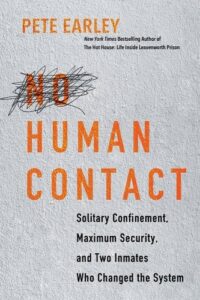SEPTEMBER 27, 1988
ISOLATION CELL, MAXIMUM SECURITY
U.S. PENITENTIARY, LEAVENWORTH, KANSAS
Don’t wear a tie, unless it’s a clip-on,” Associate Warden Lee Connor warned me. “Silverstein might grab it through the bars to choke you.”
Connor unlocked the solid steel door that led from the prison’s administration building into the bowels of the ancient penitentiary. I was being taken to interview Thomas Edward Silverstein. It would be the first and only time a journalist would be allowed to speak to him face-to-face during his lifetime. He was being held in a dungeonlike basement cell isolated from the rest of the prison population as punishment for murdering a correctional officer (CO) and committing other killings in prison. Silverstein had fatally stabbed Officer Merle Eugene Clutts forty times on the morning of October 22, 1983. Eight hours later, another prisoner, Clayton Anthony Fountain, pulled a shank on three officers and murdered Officer Robert L. Hoffman Sr.
Never before in the history of the Federal Bureau of Prisons (known by the initials BOP) had two officers been murdered by convicts on the same day in the same prison inside the same cellblock. The fallout from these brutal murders would usher in a new era in corrections—the emergence of “supermax” penitentiaries, where the “worst of the worst” inmates would be locked in solitary confinement for twenty-three hours a day, only being allowed to leave their cells in shackles and under heavy guard.
Silverstein’s and Fountain’s actions would condemn both to the most draconian punishment permitted under the U.S. Constitution. At the time of the two killings, neither man could be executed, because there was no federal death penalty. Both already had received multiple life prison terms for murders they’d committed earlier. They had nothing to fear by continuing to kill, authorities said. To prevent them from hurting prison staff and other convicts, the BOP placed both under “no human contact.” They were to be cut off from the outside world—as if they were characters in Edgar Allan Poe’s classic The Cask of Amontillado, where a victim was entombed behind a brick wall with no escape.
Silverstein and Fountain were housed initially inside tiny isolation cells, where they received only the minimum constitutional requirements. Silverstein spent nine months wearing only a pair of prison-issued boxer shorts inside a steel-lined cell that was only six feet by seven feet, almost the size of a king mattress, with nothing but a thin mattress pad and toilet inside it. He could touch its celling. The cell’s door was solid steel. Food came through a slot that otherwise was locked shut. None of the correctional officers watching him would speak to him out of deference to their fallen coworkers. No newspapers, magazines, radio, television, or visits with those outside of prison were permitted. No writing materials—neither pencils nor pens. No mail, either incoming or outgoing. The lights in his cell were kept on twenty-four hours per day and never dimmed. Clayton Fountain lived under equally harsh conditions at a different federal penitentiary. They had no meaningful human contact and nothing but their own minds to occupy their time. In private conservations, prison officials expected and quietly hoped both would break mentally and choose to end their own lives rather than spend the coming years alone in such isolation. Neither did.
Silverstein had endured five years under no human contact when I began my descent into Leavenworth’s underbelly to meet with him. By then, the BOP had begrudgingly provided Silverstein with a few niceties. This was not done out of kindness, but for control. It had proven difficult to manage him if there was nothing that he valued that could be taken away. Good behavior, for such simple acts as returning empty food trays, was being rewarded with clothing, letters from the outside world, a once-a month telephone call, and drawing materials. I was being allowed to meet him because I was writing a book, The Hot House: Life Inside Leavenworth Prison, about everyday events that happened inside the maximum-security prison. Never before had the BOP agreed to allow a writer unlimited access at one of its penitentiaries. I was allowed to roam free inside the penitentiary without an escort and speak to any convict or staff member who agreed to speak to me. Initially I intended to spend a year watching events and conducting interviews, but my research took twice as long. This was because I began alternating my prison visits. I would spend a month behind the walls and then return home for a month to review my notes, do other research, and write. At least that is what I told everyone. What I didn’t disclose was that I needed a mental break after spending a month in the predatory world that I was documenting.
Associate Warden Connor and other staff at the prison told me they were surprised that I was being permitted to interview Silverstein. I suspected J. Michael Quinlan, the BOP’s then-director, agreed to allow me access because he was convinced my sessions with Silverstein would confirm the bureau’s view that he was evil and unable to live safely outside his isolation cell. On the morning when I first met Silverstein, neither Quinlan nor I had anticipated that our encounter would lead to a thirty-two-year-long relationship carried out through letters and phone calls, which only ended when Silverstein died unexpectedly on May 11, 2019.
“Silverstein is a worthless piece of shit,” Associate Warden Connor warned as we descended a stairway into the prison’s catacombs for my first encounter with the BOP’s most hated inmate. A second solid steel door was locked at the bottom of the stairwell. It opened into a labyrinth—a sprawling dark chamber that housed the prison’s massive boilers and served as storage for stacks of dust-covered cartons filled with yellowing prison records dating to the early 1900s. Making our way through the dimness, along a narrow basement path between boxes and mothballed equipment, we reached yet another steel door. Connor unlocked it and we stepped into a small foyer containing a metal table, single folding chair, and black-and-white monitor. Its screen showed what was happening on the other side of yet another steel door.
Using a separate key, Connor opened that doorway so I could enter a rectangular room that had two sets of cell bars with a five-foot gap between them. Silverstein was locked at the far end of this shoebox-shaped chamber.
“You did sign a release, right?” Connor asked me. He already knew that I had signed a liability release on my first day inside the prison that said the BOP could not be held responsible if I was attacked, taken hostage, or worse during my visits. I suspected his question was a not-too-subtle reminder that Silverstein had killed multiple times.
Connor unlocked the first set of steel cell bars and stepped aside so I could enter the five-foot gap that separated this barrier from Silverstein’s caged cell front. Connor shut the gate behind me, twisted the key, and with a loud thunk, I was locked inside.
Silverstein’s cell reminded me of an old-fashioned sideshow circus cage, like the ones that housed exotic animals, which I’d seen in movies. Its walls and ceiling were solid steel. Heavy wire mesh was welded across the cell bars facing me. It would have been impossible for Silverstein to reach through those thumb-size holds and grab my tie to choke me.
Silverstein came from the rear of his cell much like a fish emerging from the depths of a lake. His ratted hair touched his shoulders. His beard was unkempt. He was not allowed to own a comb, brush, razor, or mirror. “Sometimes my words can’t keep up with my thoughts,” he said in a ghostly voice. “I have trouble talking because I’m out of practice.”
The fluorescent ceiling lights above us cast a greenish tint. They were never turned off because the video cameras monitoring him—including one positioned directly over his toilet—needed lighting.
“Hear that?” he asked. Neither of us spoke for a moment. A steady buzzing sound, like bees circling a hive. He glanced upward at the lights.
“Welcome to my tomb.”
_____________________


















